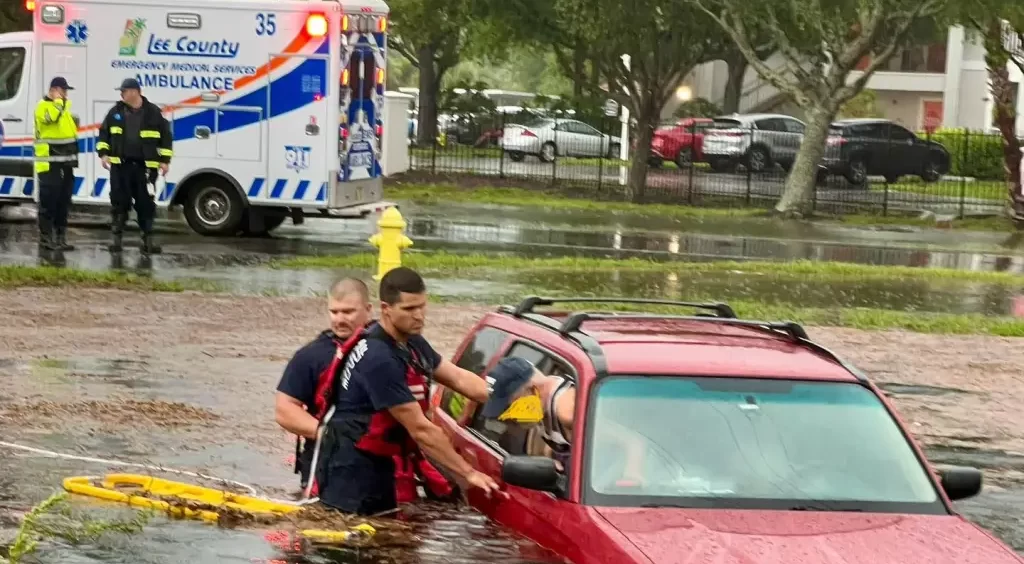Climate change presents serious challenges for communities around the world. Extreme weather events and shifting environmental conditions impact public health and safety in unprecedented ways. As a critical public service, Emergency Medical Services (EMS) face unique challenges due to these changes. This article explores how climate change impacts EMS, what adaptations are essential for effective response, and how technology, training, and preparedness can support these efforts.
Understanding Climate Change
Definition and Causes
Climate change results from an increase in greenhouse gases, causing global temperatures to rise. Human activities, such as burning fossil fuels and deforestation, contribute to this process. The result is an atmosphere that traps heat, leading to warmer temperatures worldwide. This warming effect has created shifts in natural systems, driving extreme weather patterns, and sea-level rise. Understanding these causes helps us anticipate the effects of climate change on our health and safety.
Environmental Changes
Climate change causes a variety of environmental changes that disrupt communities and ecosystems. Rising temperatures, prolonged droughts, and intensified storms are common signs of these shifts. Extreme weather events, such as hurricanes, wildfires, and floods, have grown more frequent and severe. Sea levels are also rising, threatening coastal communities and creating risks for infrastructure. These changes pose significant challenges for EMS operations, which must adapt to these new conditions to respond effectively.
Effects of Climate Change on Public Health
Heat-Related Illnesses
Heat-related illnesses, such as heatstroke and dehydration, are becoming more common as temperatures rise. Vulnerable populations, like the older people, children, and those with chronic illnesses, are especially at risk. EMS teams now face higher call volumes during heatwaves, responding to cases of severe heat exposure. Responding to these emergencies requires rapid intervention to prevent life-threatening consequences. EMS providers must stay vigilant during heatwaves and prepare for the uptick in demand.
Spread of Infectious Diseases
Climate change influences the spread of vector-borne diseases like malaria and dengue. Warmer temperatures allow disease-carrying insects to expand into new areas, spreading infections in regions previously unaffected. This shift increases the demand for EMS, as cases of these diseases rise. EMS teams must now adapt to handle these new health challenges, developing protocols for diseases that may have been rare or nonexistent in their areas.
Air Quality Degradation
Climate change has worsened air quality due to increased pollution and frequent wildfires. Pollutants, combined with smoke from fires, create respiratory issues for many people. EMS providers often respond to asthma attacks, respiratory distress, and other air quality-related emergencies. This additional demand puts strain on EMS resources and requires specialized training to manage these health issues effectively.
Impact on Emergency Medical Services Operations
Increased Emergency Calls
With climate change comes an increase in climate-related health emergencies. Heatwaves, storms, and floods drive up EMS call volumes as people experience injuries, illnesses, and stress. These extreme conditions put pressure on EMS to respond quickly, often to more cases than usual. Managing these peaks in demand challenges EMS systems, especially in heavily impacted regions. This trend calls for adaptive strategies to maintain efficiency during high-demand periods.
Operational Challenges
EMS teams face logistical challenges during extreme weather events. Flooded roads, blocked routes, and damaged infrastructure can slow response times. Wildfires and hurricanes create hazardous conditions, making access to affected areas difficult. These challenges require EMS to have contingency plans, including alternative routes and partnerships with local agencies. Addressing these issues can help EMS maintain timely and safe responses, even during severe events.
Resource Strain
Climate-related events strain EMS resources, creating shortages in equipment and personnel. Constant demand wears down equipment, requiring frequent maintenance and replacements. Additionally, EMS personnel may experience burnout due to intense schedules during disasters. Adapting to these strains involves planning for resource allocation, ensuring EMS teams stay prepared and supported.
The table below outlines major climate-related challenges faced by Emergency Medical Services and the adaptations being implemented to address them. These strategies aim to improve EMS response efficiency and community safety.
| Climate-Related Challenge | Description | Adaptations Implemented by EMS |
|---|---|---|
| Extreme Heat | Increased heat-related illnesses and injuries. | Enhanced training on heat illness and hydration protocols. |
| Flooding | Blocked roads and limited access to affected areas. | Developing alternative routes and investing in flood-resistant vehicles. |
| Wildfires | Air quality concerns and limited visibility. | Provision of respiratory protection and specialized wildfire response training. |
| Hurricanes and Storms | Increased emergency calls and resource strain. | Pre-storm readiness plans and interagency collaboration agreements. |
| Disease Outbreaks | Rising cases of vector-borne diseases due to climate shifts. | Implementing rapid response protocols and disease-specific training. |
Adaptations for Effective EMS Response
Infrastructure Enhancements
To improve resilience, EMS facilities and vehicles need upgrades to withstand extreme weather. Weather-resistant buildings and vehicles equipped for various conditions can ensure operations continue safely. In flood-prone areas, EMS facilities may require elevated locations or water-resistant structures. These infrastructure improvements help EMS maintain readiness, even as climate conditions worsen.
Strategic Planning
Preparedness plans for extreme weather events are essential for effective EMS response. EMS organizations should collaborate with weather services and local authorities to predict high-risk periods. Strategic planning also involves creating schedules that allow for extra personnel during disasters. Preparedness planning can help EMS teams respond with agility, reducing delays during critical moments.
Interagency Collaboration
Collaborating with disaster response agencies and public health organizations improves the efficiency of EMS during emergencies. Partnerships provide additional resources, helping EMS manage demand when local resources are stretched thin. Working with other organizations also enables knowledge-sharing and coordinated response strategies. By fostering these collaborations, EMS agencies enhance their capacity to serve communities during climate-related events.
Technology and Innovation in EMS
Advanced Communication Systems
Reliable communication systems are crucial during extreme weather events. Real-time weather and traffic updates allow EMS teams to avoid hazards and choose the safest routes. These systems also connect EMS teams with other emergency responders, facilitating a unified response. Investing in advanced communication tools can improve EMS response times and overall effectiveness.
Telemedicine
Telemedicine enables remote patient assessment, reducing the need for on-site visits during extreme conditions. EMS providers can use telemedicine tools to triage patients safely, especially when road access is limited. This technology supports EMS teams by allowing for initial assessments and care coordination before they reach the patient. Telemedicine helps streamline operations and reduces unnecessary exposure to environmental risks.
Data Analytics
Predictive modeling through data analytics allows EMS agencies to allocate resources effectively. Data analysis can forecast high-demand times, enabling EMS to prepare accordingly. By analyzing trends in weather patterns and call volumes, EMS can identify when and where they’ll need additional resources. This strategic insight helps EMS optimize its operations for the challenges posed by climate change.
Training and Education
Specialized Training Programs
EMS teams benefit from specialized training in disaster response and climate-related emergencies. Training on handling heat-related illnesses, respiratory issues, and infections enhances EMS readiness. These programs equip EMS personnel with the skills needed to respond effectively in high-stress situations. Ongoing training ensures EMS providers stay updated on best practices for climate-related challenges.
Community Awareness
Public education on emergency procedures can reduce the strain on EMS during extreme weather events. When communities understand how to protect themselves, EMS teams face fewer non-urgent calls. Educating the public on heat safety, air quality measures, and disease prevention empowers them to manage risks independently. By raising community awareness, EMS agencies can focus on severe cases, optimizing response times.
3 Practical Tips for EMS Providers
- Upgrade Emergency Equipment
Invest in gear that withstands extreme weather, such as water-resistant medical bags and durable transport. - Develop Flexible Staffing Models
Prepare for peak demand times with flexible staffing options, ensuring enough personnel for emergencies. - Establish Mutual Aid Agreements
Partner with nearby EMS agencies for support during high-demand periods, improving response capabilities.
Case Studies
EMS Response During Recent Hurricanes
EMS teams gain valuable insights from responding to hurricanes like Hurricane Ian. During these storms, they face accessibility issues, resource shortages, and high call volumes. Lessons from these events help EMS improve resilience and readiness for future storms. By studying past hurricane responses, EMS agencies learn practical ways to adapt and prepare for extreme weather.
Wildfire Emergency Operations
Wildfires present unique challenges, such as respiratory health issues and limited visibility. EMS teams need strategies for operating in smoke-filled environments, with protective equipment and quick evacuation plans. Wildfire response efforts have led to improvements in air quality monitoring and respiratory care for EMS teams. These adaptations support EMS teams working in hazardous wildfire conditions, ensuring community safety.
Frequently Asked Questions
How does climate change lead to increased EMS call volumes?
Climate change increases call volumes by causing more heat-related and respiratory health issues. Heatwaves, wildfires, and floods also create unsafe conditions, leading to more injuries. This rise in emergencies places higher demand on EMS. By preparing for these conditions, EMS teams can better manage high-demand periods.
What are the most common climate-related challenges for EMS?
Extreme weather and limited road access are significant challenges for EMS. These conditions make it harder to reach affected areas quickly. High call volumes and resource strains also increase pressure on EMS. Addressing these issues through planning and training helps EMS teams remain effective.
How can EMS agencies prepare for extreme weather events?
EMS agencies can prepare by investing in weather-resistant infrastructure and flexible staffing models. Training in disaster response helps EMS teams act effectively during high-risk times. Collaboration with other agencies strengthens resource availability. These preparations support quicker and safer EMS responses during extreme events.
What role does technology play in adapting EMS to climate change?
Technology improves EMS response through real-time communication, telemedicine, and data analysis. Advanced tools help EMS teams manage resources, navigate hazards, and respond efficiently. Using these technologies allows EMS agencies to adapt to climate-related challenges. Innovations like telemedicine enhance patient care when access is limited.
EMS must adapt continuously to the evolving climate landscape. Building resilience through technology, training, and collaboration will help EMS respond effectively. With proactive adaptation, EMS teams can protect communities and maintain high-quality care in the face of climate change.
References
Climate Change Indicators
The Environmental Protection Agency (EPA) offers data on various indicators of climate change, such as rising temperatures and extreme weather events, which affect emergency response services.
The Federal Emergency Management Agency (FEMA) outlines strategies for emergency preparedness, emphasizing the importance of adapting to climate-related disasters to ensure effective emergency medical services.
Climate Change and Human Health Program
The National Institute of Environmental Health Sciences (NIEHS) explores the relationship between climate change and human health, providing resources for emergency medical services to adapt to environmental changes.

Jeromy VanderMeulen is a seasoned fire service leader with over two decades of experience in emergency response, training, and public safety management. He currently serves as Battalion Chief at the Lehigh Acres Fire Control & Rescue District and is CEO of the Ricky Rescue Training Academy, a premier provider of online and blended EMT and firefighter certification programs in Florida.
Jeromy holds multiple degrees from Edison State College and the Community College of the Air Force, and is pursuing his MBA at Barry University. He maintains top-tier certifications, including Fire Officer IV, Fire Instructor III, and Fire Inspector II, and has served as a subject matter expert for a court case. He is a member or the Florida Fire Chiefs Association.
Jeromy also contributes to state-level fire safety regulation and serves on several hiring and promotional boards.

